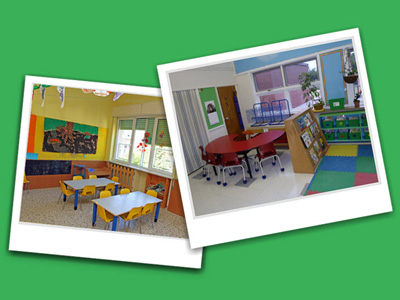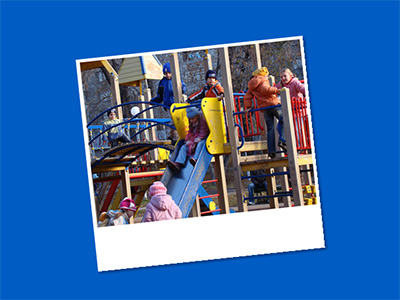 |
Course 12: Growing as a Professional in School-Age Programs |
2.00 |
Caring for school-age children in a school-age program is a relatively new field of work. The field itself is constantly changing and expanding. In view of this "newness" and change, those who work in the field are playing an important role in shaping and defining what it means to be a school-age professional. They are guiding school-age care as an emerging profession.
In the search for a definition of professionalism in school-age programs, it is helpful to examine the common characteristics of professionalism in other fields. The next step is identifying qualities and characteristics associated with professional behavior in the school-age field, itself. As a school-age professional, it is also important to understand the importance of acting as a public policy advocate on behalf of school-age children and their families.
An important part of professionalism is continued personal growth and development in relation to the field. This requires using appropriate resources and strategies to further individual professional development. It also requires considering what constitutes ethical conduct in the field and developing an ongoing commitment to ethical behavior. |
 |
Course 15: Designing Effective Indoor School-Age Play and Learning Environments |
2.00 |
Planning effective environments is the first step to planning an effective program. When environments are attractive, interesting, and comfortable, they provide a backdrop for a varied program that can address the developmental needs of school-age children. The look and feel of well-planned environments send messages that let children know they are welcome and valued. They are inviting and encourage children to get involved and stay engaged with program activities and experiences |
 |
Course 16: Developing and Implementing Effective Indoor Interest Areas |
2.00 |
In order to operate an effective school-age program environment, it is essential for staff to know how to design, set up, and operate a variety of different interest areas that meet the developmental needs of school-age children. Effective interest areas are multi-dimensional; they provide a wide variety of activity options within the area. Effective interest areas provide children with opportunities to work and play independently on their own or with others. They also provide a setting for focused, staff-led activities designed to introduce children to new concepts and skills. Staff in quality school-age programs know how to work with colleagues and children to define, develop, and manage a wide variety of interest areas |
 |
Course 19: Involving School-Age Children in Activity Planning and Implementation |
2.00 |
As they grow and change and move toward independence, school-age children and youth become very interested in planning and directing their own activities. This means it’s very important for staff to think of ways to involve them in program planning and implementation. By planning activities WITH children instead of FOR them and engaging them in creating the program environment, staff can help children develop a feeling of ownership of the program – a positive feeling that the program belongs to them. |
 |
Course 17: Developing and Implementing Effective School-Age Outdoor Environments and Interest Areas |
2.00 |
School-age children need daily opportunities to exercise, relax, and participate in a wide range of outdoor activities. The hours children spend in after school programs are often the best hours of the day for getting fresh air and enjoying the out of doors while it is still daylight. School-age programs can provide safe, secure settings where children can enjoy the out of doors. Even if outdoor space is limited, regular participation in a wide variety of physical activities in the open air can help children develop healthy exercise habits that will last a lifetime. |
 |
Course 18: Exploring Effective Schedules, Diverse Activity Formats, Planning Tools, and Staff Roles |
2.00 |
Flexible schedules make it possible to provide a varied program of activities that support the developmental needs and interests of school-age children. By establishing a flexible schedule, school-age staff can plan and implement a variety of different activity formats. To develop a balanced program, it is important for school-age staff to take a systematic approach to both short-term and long-range planning. Staff can use a variety of different planning tools to plan different types of activities. To implement a diverse program of activities, it is essential for school-age staff to recognize and use a wide variety of different roles as they interact with children throughout the program day.
|
 |
Course 23: Providing Homework Support |
2.00 |
The National Standard Objectives of Learning (SOL) have raised questions about the role of school-age programs in providing homework help and support. Research indicates there are many different ways to provide effective homework support in school-age programs. Some are more structured than others. When planning a homework support program, it is important for school-age programs to develop a homework philosophy that is consistent with the program’s overall philosophy and reflects current research on best practices for providing homework help. The homework philosophy should also reflect the needs of parents and children in the program and strike a balance between homework needs and other experiences that help children grow and learn out-of-school. When staff know how to design homework environments, identify appropriate homework materials, and use effective strategies to guide children’s efforts, homework support can be an effective component of ongoing programs. |
 |
Course 25: Focus on Health and Stress Management |
2.00 |
Every day OST professionals dedicate themselves to caring for and nurturing children, youth, and families. Often OST professionals are so dedicated to serving others, they neglect their own needs. When this happens, OST staff can experience stress that causes them to become overwhelmed, exhausted, frustrated, dissatisfied with job responsibilities, and unappreciated. When OST professionals maintain a healthy balanced lifestyle, they are in a much better position to face the challenges of supporting and nurturing children and families with positive energy, enthusiasm, patience, and empathy. By developing self-awareness; linking their personal and professional goals; developing a healthy balanced lifestyle; and identifying and managing stressors effectively, OST staff can create and maintain a positive sense of well-being that allows them to maximize their ability to build positive relationships with children, parents, colleagues, and others. |
 |
Course 26: Human Relations Skill Development: Focus on Leadership Styles and Conflict Management |
2.00 |
Research indicates that those in positions of leadership use a variety of different leadership and management styles. A person’s effectiveness as a leader is often directly linked to his or her leadership style. It is important for OST professionals to be aware of the assumptions and characteristics of different leadership styles. Knowledge of different leadership styles can help OST professionals reflect on their own leadership style and assess its effectiveness. It can also help OST professionals take a proactive approach to applying different leadership styles and techniques, depending on the situation.
Leaders also use a variety of different styles when it comes to managing and resolving conflicts. By understanding how to diagnose the causes and dynamics of conflict and understanding the characteristics of different conflict management styles, OST professionals can choose the best conflict management strategy for each situation.
There are a number of skills that enhance the ability of OST professionals to employ different leadership and conflict management styles effectively. When OST professionals are aware of these skills and their own skill levels, they can set priorities for ongoing development of leadership skills. |
 |
Course 27: Exploring Ethics in School-Age Care: Focus on a Professional Code of Ethics |
2.00 |
According to Frank Loewenberg and Ralph Dolgoff, developing a code of ethics is a significant stage for any profession. “For most American occupational groups the development of a code of ethics coincided, more or less, with the decision to formalize the transformation of the occupation into a profession.” The transformation to a profession allows those working in the profession continuity and heightened sense of purpose. It allows those outside of the profession to realize the integrity and importance of the profession.
When OST/SAC professionals develop, adopt, and adhere to a Code of Ethics, they are guided by underlying principles that represent the values of the OST field. These underlying principles help them determine appropriate courses of action when they face ethical issues as they work with children, parents, colleagues, and community members. |
 |
Course 29: Making Plans and Developing Policies |
2.00 |
Planning and policy-making are closely linked to the development of quality OST programs. When OST staff are skilled as planners and policy-makers, they can use these skills to design and implement high quality programs that benefit children, youth, and families. It is essential for OST professionals to recognize that it is important for policies to grow out of a vision of quality and a mission that supports that vision. Therefore, creating a vision for quality, developing a program philosophy, and writing a clear mission statement are the first steps in program planning. It is also important for OST professionals to use a systematic process to develop goals and objectives, set priorities for accomplishing goals and objectives, and develop goal-based action plans that will help the OST program achieve its mission. High quality OST programs are led by professionals who understand how to use effective strategies for creating a continuous cycle of planning and evaluation that supports ongoing program improvement. |
 |
Course 31: The Six "Ps" of Marketing School-Age Programs |
2.00 |
Effective marketing of OST programs is a systematic process that involves research, analysis, assessment of market trends and needs, short-term and long-term planning, and development of effective strategies to promote OST program services and develop a positive image of the program in the community. It is important for OST leaders to recognize that marketing is a far reaching process that includes, but is not limited to, advertising and publicity. When OST leaders take a comprehensive approach to marketing, their programs and projects have an excellent chance of success. Knowledge and understanding of the marketing process is an invaluable tool for OST leaders as they plan and implement new programs and projects, assess the stability and need for improvement of current programs, develop plans for new or expanded programs, and develop a positive public image of the program and its services. |
 |
Course 34: Creating Community Collaborations |
2.00 |
Across the country, more and more communities are forming community collaborations to address the out-of-school needs of children and youth of all ages. When different segments of the community join together, share ideas, and pool their resources and efforts to create OST initiatives, children and youth benefit. What one organization or program may not be able to accomplish alone, is often achievable when partnerships and collaborations among diverse groups and individuals are formed.
When OST professionals are knowledgeable about what it takes to create and sustain successful collaborations, they can play an important leadership role in creating OST initiatives and programs that will meet the needs of children and youth in their communities now and in the future.
|
 |
Course 33: Youth Development Trends: Focus on Older Youth |
2.00 |
The Center for Early Adolescence at the University of North Carolina and the Search Institute have found that early adolescence is a time of rapid change in youth development and developmental needs. For many children, the characteristic needs of early adolescence begin to emerge as early as age nine, when children are still in elementary school and attending traditional OST programs. OST professionals who understand these emerging needs are better equipped to create successful program experiences with older children in their programs.
The number of quality OST programs for children between five and twelve is steadily growing across the country. At the same time, there is increasing public interest in establishing programs that can also address and support the out-of-school needs of children over age twelve. For many years, communities tried to meet the needs of older youth by a problem-solving approach that focused on helping youth by fixing what was wrong. New trends in youth development take a more positive approach and are focused on working with youth to create positive outcomes.
OST professionals who are knowledgeable about adolescent development and developmental needs and are knowledgeable about youth development research and trends can play important roles in helping their communities design and develop the next level of program services for children over the age of twelve. By learning about ways to support the developmental needs of older youth, OST professionals can join with others to create strategies and programs for continuing to build on the positive experiences younger children have in their OST programs. |
 |
Course 32: Current Trends and Issues in Out-of-School Time Programs |
2.00 |
It is important for OST professionals to understand how the field has developed since its inception and to be knowledgeable about the current status of the OST field. With this knowledge and understanding, it is possible for OST professionals to participate in shaping the field as it grows in the future.
The field of OST is growing and changing as national researchers learn more about what works best in OST programs for a wide range of children and youth, their families, and their communities. Other positive changes are occurring as advocates for OST succeed in creating more public awareness about the need to make quality OST services available to all children and youth across the country. In addition, the OST field is undergoing a metamorphosis as experienced professionals in several different disciplines and fields share and contribute their knowledge, skills, and insights with the goal of creating national models that represent the best possible OST programs.
In this climate of change, OST programs face a number of important issues, revolving around the availability, affordability, and accountability of programs. Many national trends and issues have implications for OST at the state and local level. When OST professionals are well informed about national developments in the field, they can become more effective OST advocates as they design and implement high quality, sustainable programs that are responsive to youth, family, and community needs. |
 |
Course 36: Sharing Information with Parents and Other Professionals |
2.00 |
School-age children work on many important developmental tasks during their out-of-school hours. One of the important responsibilities of OST staff is to help parents stay in touch with how their children are growing and developing during program hours. In addition to parents, professionals who work with children in other settings are often interested in learning how children spend their time when they are not at home or school.
Portfolios are excellent tools for bringing children’s experiences in OST programs to life for parents during planned parent conferences. They are also valuable tools for sharing helpful information about children with other professionals. |
 |
Elephants |
2.00 |
This course will provide an introduction to elephants, including an overview of physical characteristics, habitat, behavior, reproduction and the conservation efforts dedicated to protecting this species. |
 |
Exploring Four Areas of School-Age Development (Collection) |
2.00 |
One of the most helpful ways to gain an understanding of the needs and interests of youth between 5 and 12 is to examine their development from four different perspectives: 1) Physical Development, 2) Cognitive Development, 3) Social Development, and 4) Emotional Development. It is important for staff to keep all four of these areas in mind when planning and implementing program activities and experiences. Keeping the four areas of development in mind leads staff to design a balanced set of experiences that nurture and growth and development of the "whole child." |
 |
Exploring Developmental Needs and Characteristics (Collection) |
2.00 |
Certain developmental needs and traits are associated with younger school-age children, while others are typical of older school-age children and youth. While the differences between school-age children of different ages are not clear-cut, there are some general traits and tasks that are often associated with younger (ages 5 – 7), middle (ages 8 – 10), and older (ages 11 – 12) school-age children and youth. Understanding these differences helps staff plan appropriate activities and guidance strategies for children of different ages. |
 |
Providing Homework Support (Collection) |
2.00 |
The National Standard Objectives of Learning (SOL) have raised questions about the role of school-age programs in providing homework help and support. Research indicates there are many different ways to provide effective homework support in school-age programs. Some are more structured than others. When planning a homework support program, it is important for school-age programs to develop a homework philosophy that is consistent with the program’s overall philosophy and reflects current research on best practices for providing homework help. The homework philosophy should also reflect the needs of parents and children in the program and strike a balance between homework needs and other experiences that help children grow and learn out-of-school. When staff know how to design homework environments, identify appropriate homework materials, and use effective strategies to guide children’s efforts, homework support can be an effective component of ongoing programs. |
 |
Helping Children with ADD Succeed In School-Age Programs (Collection) |
2.00 |
Children with ADD regularly experience struggles and challenges at home, in school, and in the community. Without the help of knowledgeable, understanding, and supportive people, they often experience multiple failures and frustrations on a daily basis. Typically, they lack the self-confidence that stems from learning how to do things well. Their lack of social skills and self-control makes it hard for them to make friends with schoolmates and children they meet in program activities. By the school-age years, many of these children do not feel good about themselves. They feel lonely and ostracized. Their self-esteem sinks a little lower every day.
Staff in school-age programs are in a position to make a positive difference in the lives of children with ADD. Armed with important information and management tools, they can help reverse the cycle of failure and frustration that results in low self-esteem in these children. They can make life easier, happier, and more satisfying for children with ADD, their parents, other children in the program, and themselves.
IMPORTANT NOTE: ADD stands for Attention Deficit disorder. Many professionals refer to this disorder as ADHD, which stands for Attention Deficit Hyperactivity Disorder. Some professionals use these terms simultaneously or interchangeably. In this module, the term ADD is used to refer to the basic form of the disorder and recognizes that the basic pattern of inattention associated with ADD often includes the component of hyperactivity related to extremes in temperament. |
 |
Growing as a Professional: Health and Stress Management (Collection) |
2.00 |
An important part of professionalism in the school-age field is continued personal growth and development in relation to the field. This requires using appropriate resources and strategies to further individual professional development. In this course, we will explore professional development opportunities for school-age staff. |
 |
Human Relations Skill Development: Focus on Leadership Styles and Conflict Management (Collection) |
2.00 |
Research indicates that those in positions of leadership use a variety of different leadership and management styles. A person’s effectiveness as a leader is often directly linked to his or her leadership style. It is important for OST professionals to be aware of the assumptions and characteristics of different leadership styles. Knowledge of different leadership styles can help OST professionals reflect on their own leadership style and assess its effectiveness. It can also help OST professionals take a proactive approach to applying different leadership styles and techniques, depending on the situation.
Leaders also use a variety of different styles when it comes to managing and resolving conflicts. By understanding how to diagnose the causes and dynamics of conflict and understanding the characteristics of different conflict management styles, OST professionals can choose the best conflict management strategy for each situation.
There are a number of skills that enhance the ability of OST professionals to employ different leadership and conflict management styles effectively. When OST professionals are aware of these skills and their own skill levels, they can set priorities for ongoing development of leadership skills. |
 |
Emergency Animal Recall - Polar Bears |
2.00 |
Welcome to Emergency Animal Recall. This Overview course covers the fundamentals of Emergency Recall training for exhibit animals, including:
What exactly is Emergency Animal Recall, and why is it necessary?
What are the benefits of Emergency Animal Recall?
How do you generate support within your organization for a training program, and how do you decide which animals should be trained first?
What equipment will you need, and what preparations will you need to make?
What is the general outline of an Emergency Recall training program, and how do you maintain the conditioning once it has been established?
This is the first course in a series. After completing this Overview, you should continue with the species-specific Polar Bear Emergency Animal Recall course. |
 |
Emergency Animal Recall - Brown Bears |
2.00 |
Welcome to Emergency Animal Recall. This collection consists of an overview course which covers the fundamentals of Emergency Recall training for exhibit animals, including:
What exactly is Emergency Animal Recall, and why is it necessary?
What are the benefits of Emergency Animal Recall?
How do you generate support within your organization for a training program, and how do you decide which animals should be trained first?
What equipment will you need, and what preparations will you need to make?
What is the general outline of an Emergency Recall training program, and how do you maintain the conditioning once it has been established?
After completing this Overview, you can continue with the species-specific Brown Bear Emergency Animal Recall course. |

























